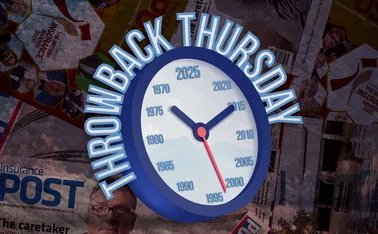
Credit hire roundtable: necessary evil or essential service?

The insurance industry’s perpetually uneasy relationship with credit hire has often flared up into hostility. Judging by the tone of the exchanges at a recent roundtable, the current mood is much calmer, with a greater willingness to explore ways of removing the friction and excessive costs that blight the market
Last summer, seven former employees of Autofocus received jail sentences for perjury after they doctored invoices. But this dispute between insurers and credit-hire companies was seen by participants as an isolated incident that should not deflect from the progress they are making.
The feeling was that it would be in no one’s interest to keep talking about it: “I don’t think the general public even know about it or care about it,” said Simon Gallimore, senior complex casualty claims manager at AIG UK.
“It’s yesterday’s news,” said Nick Garner, CEO at MSL. He stressed the Competition and Markets Authority enquiry had endorsed the General Terms of Agreement between insurers and Credit Hire Organisations. “We have a positive point for the industry to move forward from.”
Insurers too share that desire to look ahead rather than dwell on the past, said Elaine Clark, group third-party claims operations manager at Markerstudy: “We’ve definitely come a long way around protocols. We still have some way to go but hopefully they will help build back some of that trust.”
Those with long experience in the market were quick to endorse that sense of improving relationships, even if that didn’t always make the future easy to predict.
“The landscape has changed for insurers and credit-hire companies,” said Shaun Leonard, credit-hire manager at Allianz. “It is over 20 years that I have been involved in credit hire and it doesn’t look the same now as when I first started.
“The protocols have definitely changed things, so we are operating in a different space now. New relationships have been built, although some have been destroyed along the way. The challenge is forecasting whether there is a future for credit hire,” added Leonard.
This provoked an instant response from James Roberts, business development director – insurance at Europcar, who said he had heard many predictions of the demise of credit hire and they were all wrong. “It has got a long future,” he said.
Whether it deserved this future was challenged by Gallimore who thrust the ever-sensitive topic of referral fees – which AIG doesn’t pay – into the debate. He said these fees drive up the cost of hire and, therefore, insurance premiums too: “It is absolutely crazy that the insurance industry is fuelling this industry and demanding an income from something which we are publicly condemning. I am not sure we should be celebrating credit hire as an industry or working out how to find ways to remove it.”
This brought the current chair of The Credit Hire Organisation, Kirsty McKno, into the debate.
“During the CMA enquiry, when it was asking for recommendations about alternative models of mandatory hire, it was the insurers that said no to that.”
She was backed up by Emma Fuller, partner and head of credit hire with DAC Beachcroft: “Everyone said they wanted a solution but no one could find one.”
Miles Keeble, senior consultant for Europcar, said insurers should realise how much they benefit from credit hire: “Is the insurer prepared to take the risk and provide the service themselves? I am sure credit hire provides a fantastic service that takes that risk away from the insurer,” he said, adding for the benefit of the insurers in the room: “You get credited with a lot of excellent customer service the credit hire company provides for very little cost.”
Clark urged people to step back and look at this from the customer’s perspective: “We’ve almost lost sight of the fact that this is about a person who has had an accident and needs mobility. That should be provided in the most efficient way for them in terms of how they get it and how much it costs.”
Referral fees
Referral fees are always a sensitive issue and are back in the melting pot when it comes to credit hire, not least because The CHO itself is openly discussing with its members how they should be handled, said McKno.
“It plays into the GTA rate review and the discussions there have gone around the table in respect of referral fees and whether they should be considered part of that overarching rate review. Is that right or wrong, because referral fees sit in a different part of insurers’ balance sheets?”
There was agreement around the table that it would need regulatory action if referral fees were to go and that they couldn’t be targeted in isolation from other issues in the market and without taking into account the business models of CHCs.
“That was an issue with a lot of the suggestions that came out of the CMA,” said Fuller. “You can’t just tackle one issue in isolation. It has to be part of a whole package like the whiplash reforms.”
She wasn’t optimistic about reform in this area making much progress: “Trying to get a consensus among insurers, let alone between insurers and credit-hire companies, as to what that should look like is a nightmare.”
Philip Strong, third-party technical claims consultant for CHMC, which handles claims for Acromas and Saga, said the end of referral fees would improve the market but would require legislation.
Leonard said insurers had plenty of reasons to welcome the rate review but were nervous about how it might work out: “Will the GTA survive a rate review or could it fracture? If that does happen, it will lead to a more frictional and contentious credit-hire landscape, such as we had 10 years ago.
“It is about how much you value those relationships and how you are going to maintain them going forward. If there was no GTA, you would have to go out and formulate those relationships.”
Despite his doubts about the wider value of credit hire, Gallimore wanted the GTA to survive: “It gives a structure to the market which particularly benefits smaller players, so that helps give the market a future.”
When it came to other suggestions about where to look for ways of reducing the cost of credit hire, the conversation focused on duration and the expectation of like-for-like vehicles.
Insurers frequently complain about what they see as excessive repair times and thus extended credit hire period. This is a genuine problem but insurers contribute to it, said Mike King, national third-party claims strategy manager for LV.
“If you talk about duration and repair management, a CHC that is driving credit repair can be up to 35% less in duration than one that throws it over to an insurance engineer and asks them to authorise it on a third-party basis. They know full well that will take a long time to assess.”
Garner said CHCs had a zero incentive to inflate bills in this way: “We know that if there is an extended duration, we are not going to get paid.”
This issue is high on the agenda at The CHO, said McKno.
“We need to develop best practice between us on issues such as duration. We need to encourage CHCs to move away from a long duration model to a short duration model. You are more likely to get paid for a short duration.”
Kitemark consideration
Insurers said they also had issues about the clarity and transparency of invoices and had to spend far too much time checking them, adding to their costs.
McKno said The CHO was considering a GTA kitemark, an idea that was in its early stages of development but would clearly win support from many around the table.
“A kitemark about creating an elite form of credit-hire company where there is better collaboration and more trust” would be a big win for the market, said King.
This and the other discussions around the next iteration of the GTA – a ‘GTA2’ – had at their heart the need to understand that there are better ways to achieve the mobility the customer requires, said McKno.
Mobility was a theme that participants warmed to and it took them right to the heart of the ever-present arguments about like-for-like vehicles and the inflexibility of the present groupings in the GTA. These were seen as very out-of-date, something McKno acknowledged was a major issue: “We spend so much time talking about rates, other issues such as groupings get overlooked.”
With automotive technology and design moving ahead apace, Roberts stressed the urgency of revisiting the groupings and the expectation of like-for-like replacement.
“We are talking to manufacturers about smaller engines, greener vehicles that have greater power output and customers like that.
“We are being penalised by our referral sources because if we do not do that [like-for-like] it looks as if we have downgraded the customer. Our leisure customers say small engines, our insurer customers say big engines, so we are stuck.”
Gallimore accepted this, admitting: “We are too fixated on like-for-like rather than delivering a mobility solution.”
Moving away from the traditional approach will not be easy, as litigation has entrenched the like-for-like model, said McKno.
Other advances were pushing against the current credit-hire model too, said Clark: “What impact will the sharing economy have? It is no longer the be-all and end-all to own your own car. And telematics is already pushing the first notification of loss to the vehicle manufacturers who are growing in power in the repair market.”
The credit-hire market is not oblivious to these changes, said McKno, although she feared the sharing economy “might sound the death knell for credit hire”.
Mention of driverless cars just prompted nervous laughter around the table.
Participants felt rather more confident when tackling the suggestion that first-party subrogation might be a way forward.
“First-party subrogated hire seems logical but it could be more expensive overall,” said Leonard.
King went slightly further saying it had been talked about for 15 years but had never progressed because of the vested interests, despite being the right solution.
McKno reinforced his point about vested interests by pointing out that insurers had said no to it in their submission to the CMA enquiry.
Keeble was less convinced that it might offer a better way of handling credit hire: “First-party sounded good but it could be costly. There is also a danger that it will be about downgrading and not like-for-like.”
Portal possibility
One idea that did attract support around the table, at least in principle, was the creation of a portal for handling credit hire. Some saw this as a way of modernising some of the GTA processes, which can be cumbersome.
“A portal would be a good way forward if it helps reduce our costs,” said Jackie Britton, credit hire technical consultant for QBE.
Others agreed. “We see lots of different credit-hire firms with different paperwork, some electronic, some still being signed off at the rental station. Some standardisation would help reduce costs,” said Roberts.
Leonard backed him up on this: “Greater rigour would remove arguments around ambiguity and a kitemark or GTA2 would definitely ease that even further.”
There were some words of caution, especially around the challenge of getting credit firms outside the GTA into a portal. Clark felt that it was a worthy objective but would have to be a government-backed scheme to work. Fuller warned “there is no magic wand” for solving many of the issues discussed.
Despite these caveats, the prospect of a portal-style solution combined with other initiatives such as the revision of the GTA and the introduction of a kitemark scheme gave many round the table a feeling of confidence that the future relationship between insurers and credit hire companies would continue to improve.
The tone of polite engagement certainly suggested that optimism was not without foundation.
Further reading
Only users who have a paid subscription or are part of a corporate subscription are able to print or copy content.
To access these options, along with all other subscription benefits, please contact info@postonline.co.uk or view our subscription options here: https://subscriptions.postonline.co.uk/subscribe
You are currently unable to print this content. Please contact info@postonline.co.uk to find out more.
You are currently unable to copy this content. Please contact info@postonline.co.uk to find out more.
Copyright Infopro Digital Limited. All rights reserved.
As outlined in our terms and conditions, https://www.infopro-digital.com/terms-and-conditions/subscriptions/ (point 2.4), printing is limited to a single copy.
If you would like to purchase additional rights please email info@postonline.co.uk
Copyright Infopro Digital Limited. All rights reserved.
You may share this content using our article tools. As outlined in our terms and conditions, https://www.infopro-digital.com/terms-and-conditions/subscriptions/ (clause 2.4), an Authorised User may only make one copy of the materials for their own personal use. You must also comply with the restrictions in clause 2.5.
If you would like to purchase additional rights please email info@postonline.co.uk








